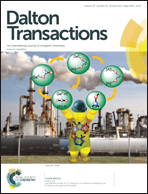Does a higher metal oxidation state necessarily imply higher reactivity toward H-atom transfer? A computational study of C–H bond oxidation by high-valent iron-oxo and -nitrido complexes†
Abstract
In this work, the reactions of C–H bond activation by two series of iron-oxo (1 (FeIV), 2 (FeV), 3 (FeVI)) and -nitrido model complexes (4 (FeIV), 5 (FeV), 6 (FeVI)) with a nearly identical coordination geometry but varying iron oxidation states ranging from IV to VI were comprehensively investigated using density functional theory. We found that in a distorted octahedral coordination environment, the iron-oxo species and their isoelectronic nitrido analogues feature totally different intrinsic reactivities toward C–H bond cleavage. In the case of the iron-oxo complexes, the reaction barrier monotonically decreases as the iron oxidation state increases, consistent with the gradually enhanced electrophilicity across the series. The iron-nitrido complex is less reactive than its isoelectronic iron-oxo species, and more interestingly, a counterintuitive reactivity pattern was observed, i.e. the activation barriers essentially remain constant independent of the iron oxidation states. The detailed analysis using the Polanyi principle demonstrates that the different reactivities between these two series originate from the distinct thermodynamic driving forces, more specifically, the bond dissociation energies (BDEE–Hs, E = O, N) of the nascent E–H bonds in the FeE–H products. Further decomposition of the BDEE–Hs into the electron and proton affinity components shed light on how the oxidation states modulate the BDEE–Hs of the two series.


 Please wait while we load your content...
Please wait while we load your content...